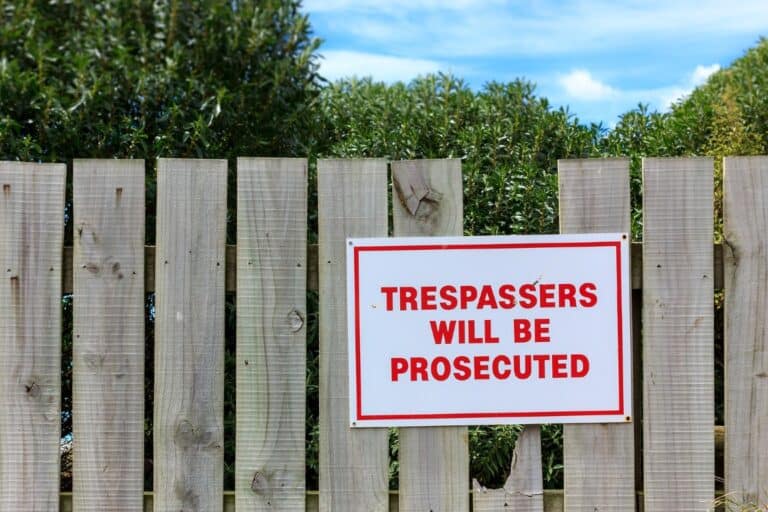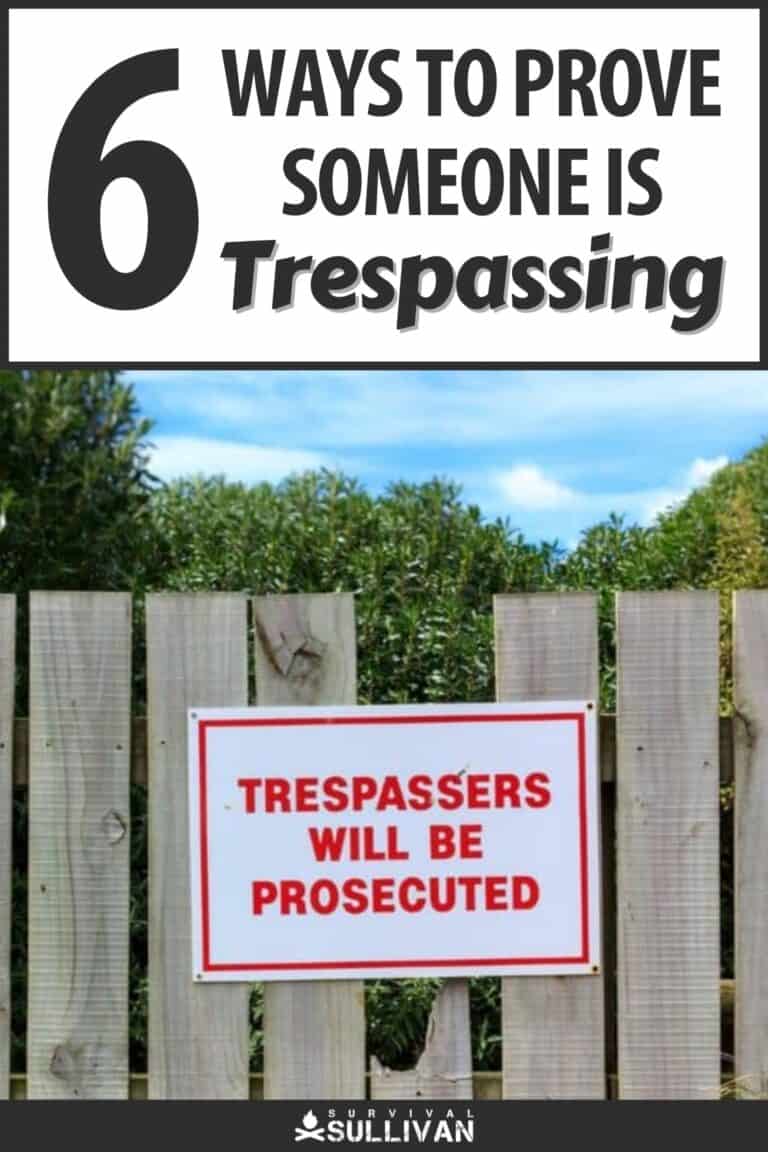How can you prove someone is trespassing? Without any actual evidence of the crime being committed, it’s your word versus theirs, and it getting charges pressed can prove to be frustratingly difficult.

But, with the right approach and a little bit of homework, it’s possible to prove that someone is trespassing on your property easily enough, and that will make all of the following proceedings go that much easier.
So, what are some ways to prove to someone is trespassing?
You can approve that someone is trespassing by posting conspicuous signage or markings, notifying the trespasser and writing or verbally, take photographs or video recordings of them in the act, or letting the police make contact with them. If you can get the matter to court, you can let your lawyer prove it.
Proving that someone is trespassing on your property, especially if it’s a very large and unimproved parcel, can be difficult.
It doesn’t matter if you’re doing anything with the property or not; it is yours, and you should enjoy unfettered access to it and the right to keep anyone off of it that you want.
But, getting proof of a trespasser will make pressing charges against them a whole lot simpler, so it pays to be prepared. Keep reading and I’ll tell you about six ways to do just that…
Table of Contents
1. Post Signs or Markings
It sounds a little strange, or even a weak way to make your case, but posting state-approved signage or paint markings is one of the best ways that you can prove someone is trespassing on your property once it is actually time to kick things off and press charges.
This is because many states will actually mandate the posting of signs or markings, and on top of that, signs with specific language, of a specific size, and spaced at a given interval, in order for it to count as notification to anyone that trespassing on the property is forbidden.
If you do this, and do it according to the letter of the law, it’ll be much easier to get trespassing charges to stick when it’s time to take someone to the mat, legally speaking.
And I know it sounds tedious, but make sure that you find out exactly what your state requires when it comes to posted signage.
You might have to post signs with your name and address or other contact information in addition to the usual no trespassing language. Done right, no one will be able to honestly say that they didn’t see the sign before they came on your property.
2. Notify in Writing or Verbally
Another great idea, and another step that is sometimes required depending on the state you live in, is to notify the trespasser verbally or in writing that they are forbidden from setting foot on your property again.
This is a great way to deal with an incidental trespasser, or a known troublemaker like a quarrelsome neighbor or somebody that is keeping up a campaign of stalking or harassment against you.
Much of the time, if someone is on your property politely but firmly, telling them that they are trespassing and they need to clear off and stay away is enough to end the problem.
If it isn’t, and you’ve given official, verbal notice to a repeat offender, make it a point to have a trustworthy witness with you to back up your claim.
Another good way to notify is in writing via certified letter. Done properly, the recipients will not be able to say they never heard from you or never told to stay away.
Depending on the situation, this is something the police might be able to do for you, and you had better believe that the court is going to believe them if it comes down to making an actual case against the trespasser.
3. Photographs
As always, a picture is worth a thousand words.
If you’re able to take photos of someone actually trespassing on your property, and even better if you’re able to have them time and date stamped, you should have all the evidence you need to prove, without question, that the person of interest was in fact trespassing.
Depending on your property and the specific circumstances, you might be able to do this with your camera phone, or it might be best to take some long-range pics with digital camera and a telephoto lens.
But whatever you do, take a bunch of them! Do your best to get high-quality shots of the person and all of the relevant physical details, and more than anything get pictures of their face.
If they are trespassing in a vehicle or arrived in a vehicle prior to entering, get a couple shots of the vehicle and the license plate.
4. Video Recordings
Video recordings are even more damning than photographs much of the time. Recordings will also show how a person was conducting themselves, or their overall posture, while on your property.
If someone looks furtive and guilty, that isn’t going to help them when it goes to court.
Similarly, a good surveillance camera clip might show them bypassing fencing or ignoring signage, or committing some other criminal act while on your property, and then you’ll really have them sewn up.
Something else to consider, and a huge asset if you have a larger property or want to make a quick sweep for trespassers, is a drone.
Even low-end drones fly very high, very quiet, and have excellent cameras that can take really good photographs and video.
They’re also capable of dipping down quickly to get close-up shots of people or vehicles. But before you invest in your own personal air force, make sure you look up the drone usage and recording laws in your state.
Some states have very stringent requirements when it comes to recording people through the use of a drone or other remotely operated vehicle.
You should be fine since you’re flying the drone only over your property and they are the ones that shouldn’t be there, but better safe than sorry…
5. Police Contact
If you know someone is on your property, and that they have been spending a significant amount of time on it, just call the police and let them make contact with the trespasser, preferably taking you along with them if it’s safe.
This is the very best way to get the ball rolling if you can pull it off. The police will have you there and make the trespasser acknowledge that you, the property owner, is telling them that they are trespassing and that they should not return to the property.
The law enforcement will have a record of the interaction and their own evidence and observations of infractions or violations committed. All this will be admissible in court.
If the trespasser wants to push their luck, they won’t come out on the winning end of the interaction.
6. Let the Lawyer Handle It
Lastly, you can just let your lawyer take care of it. If you’re able to press charges, criminally or civilly, and get the matter into court in front of a judge or a judge and jury, let the lawyers do their job.
A good prosecutor will be able to construct a legal argument that the person who was illegally, unlawfully on your property entered or remained there without permission, and that they knew or should have known that the property was off limits to them and entered anyway.
This will completely dissolve any argument of ignorance that a person might try to use to defend themselves.
You can make your lawyer’s job much easier if your property is secured, either with barriers like fencing, hedges, walls or something like that, or if you have posted it properly and in accordance with state law via signs or paint markings.
Even if the suspect claims that they didn’t see them or that they weren’t there, they will be walking a tightrope of deception that a skilled attorney will be able to upset, catching them in a lie and proving your case: that the accused was, in fact, actually, trespassing.
Getting evidence on your own that a person is trespassing will make your case a lot easier, but if you are adamant and you know you’re in the right sometimes it’s best to just get your day in court and let the lawyers duke it out; you’ll usually win.


Tom Marlowe practically grew up with a gun in his hand, and has held all kinds of jobs in the gun industry: range safety, sales, instruction and consulting, Tom has the experience to help civilian shooters figure out what will work best for them.
